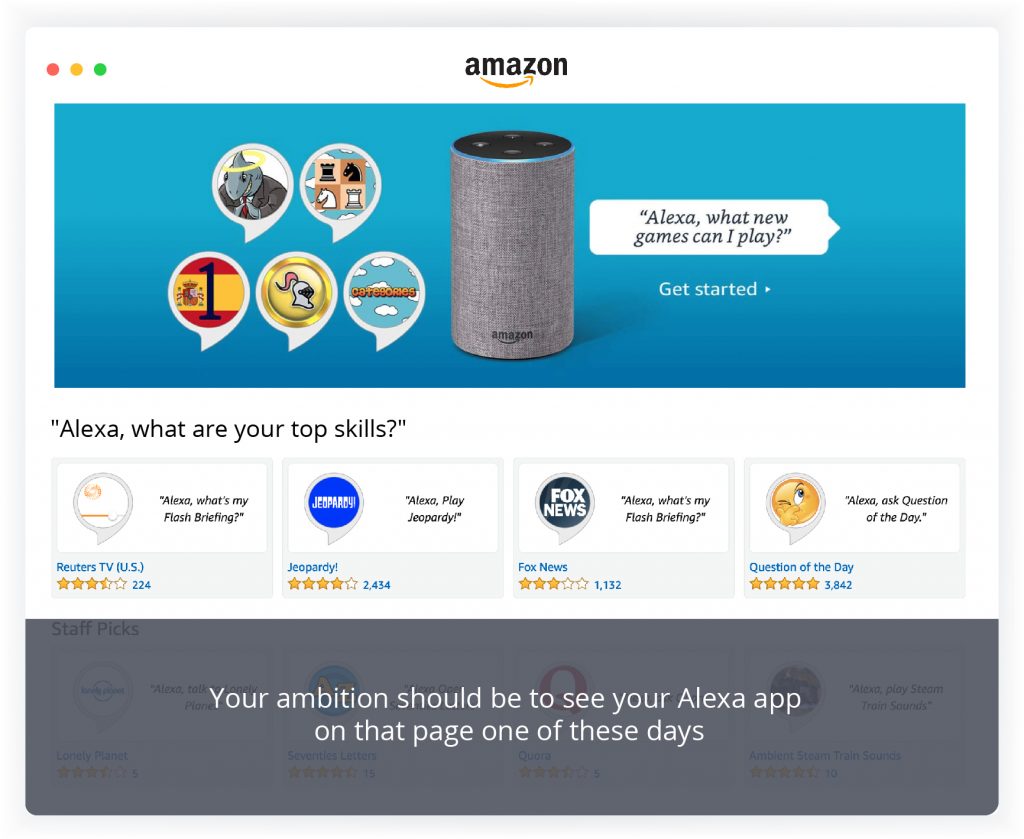How to Create Best Alexa Skills for Your Customers and Your Business

The real global connectivity between people, places, and things is emerging before our eyes. Billions of devices are going to be connected and powered by BD analytics, machine learning, and edge computing to change, among other things, the commercial models and relationships with consumers. IoT solutions will redefine how retailers bring shoppers into their physical and online stores, make personalized offers, help along the purchasing process, facilitate a fast, convenient, and secure payment, and provide customer support.
Amazon Alexa is part of that revolution. After Prime members learned to shop using voice commands, Alexa has taken e-commerce to a new level. Although direct advertising and sales are not generally allowed, emerging applications let brands reach customers on a new level. Millions of homes and offices already have Amazon Echo, Echo Dot, Echo Show, Fire TV, and other compatible devices. These smart devices can not only serve content in the form of news, weather updates, etc. but also improve the customer experience that businesses are offering.
A range of Samsung’s smart home appliances already can be controlled with an Alexa-enabled device thanks to the Samsung SmartThings Alexa Skill. Owners of Echo can ask Alexa to turn Sony’s TVs on and off or to control volume. With Alexa’s Smart Home Skill API, more manufacturers will enable the functionality and add more skills soon. Integrating Alexa capabilities with existing web apps leads to the creation of new exciting solutions.
Amazon skill platform itself promotes creativity. Blueprints for Alexa enable even hobbyists to create simple skills for their Echo devices. Alexa Skills Kit (ASK) helps to get started with more complex interaction models. Then, developers can branch out and code more engaging apps that are integrated with other IoT devices.
The number of apps on the Alexa Skills Store in the U.S. has exceeded 30K and keeps growing. Some apps get widespread adoption while others fall short of the mark. In this post, we’ll list the primary success criteria along with some tips to make your Alexa app not only useful for the end-users but also a source of new leads, sales or readers.
Traits of the Best Alexa Skills

The secret of building a perfect Alexa skill is to create something that people will use every day. Having examined the best Alexa skills, Amazon found out that they share the following qualities:
- A good Alexa skill not only offers a more convenient solution than the existing method(s) but combines the convenience with speed.
- The skill sets clear expectations on its abilities.
- The interaction flows smoothly, and no ambiguity hinders users from moving forward to achieve their goal.
- Using an Alexa skill should feel like speaking with a nice person. Users need to talk to Alexa naturally and spontaneously. She must understand most requests and either execute the command or inform the user why she can’t do it.
- Skills that provide fresh content tend to drive more regular usage over time; skills that don’t offer new facts or questions don’t see consistent engagement.
- Users must be able to interact with Alexa regardless of their location or the device they are talking to. The voice experience must work as consistently and reliably as the core Alexa experience.
- An intuitive, natural to say and memorable name of the skill is important. It shouldn’t be longer or more difficult to pronounce than a similar skill’s name.
For an excellent customer experience, skills must incorporate each of these qualities. The next chapter gives some practical tips on how to do that.
Tips for Success
A thorough target audience research is indispensable. Start with the following questions:
- Who are the target users?
- How do they use Alexa in their everyday lives?
- What is their issue that is related to your core product that an Alexa app can solve?
- What Alexa capabilities can be leveraged for that purpose?
Choosing the use case for Alexa, start focusing on the higher utility level. “Doing” or “searching” capabilities will provide your customers with the easiest access to services or information.

Skills that control multiple smart home appliances are the best example of an existing “doing” experience made better with voice. Other handy categories seem to deal with audio, food, travel, education, health and fitness, productivity, and games. Skills that provide value while seamlessly fitting into a customer’s routine are the best. Try to combine Alexa’s abilities to solve a real-world problem with the power of your product or service.
Let us give a few examples. Gettysburg College in Pennsylvania built Alexa skills to let over 2,600 students, faculty, and staff members find, search for, and create useful content for the campus. Simple Recon created a skills package that enables auto dealers to track their inventory and receive updates. Managers can monitor the progress of repair projects. A custom Alexa skill can help hotel guests request room service or order favorite dishes from your restaurant. Even simple Q&A Alexa Blueprints can come in handy, e.g., as an Alexa app that will answer the buyers’ questions about products purchased from you and provide support when they run into problems.
Improved customer service and after-care are crucial for shaping a brand image and increasing customer loyalty. In this context, your Alexa app must emulate the qualities of a superb customer service professional. These include intelligence, empathy, politeness, and goal-driven personalized approach, to name a few.
In all cases approach your Alexa skill from the end-user’s perspective. The skill’s name should articulate its abilities straight away. To test your ideas, ask people to say each invocation name out loud and grade its strength. Will it help the customers easily discover your Alexa app? Can they remember it? After the publication, check the reviews for any issues caused by the app name.
Users should make requests without thinking about the format or context. They don’t have to think about what to say or remember how to say it. Look out for potential stumbling blocks, e.g., odd or lengthy invocations, artificial skill syntax or the need to repeat commands.
Try to avoid pain points or friction. For example, account linking provides authentication when the identity of the Alexa user must be associated with an account in your system. It’s a useful way to collect information that is difficult to recognize via voice, e.g., email addresses. However, it prevents the process from being completed seamlessly with voice. Therefore, it’s not recommended to use account linking unless the resulting customer value offsets the friction.
The main reason for requests not being understood is a lack of sample utterances in the interaction model. A skill may need up to a hundred utterances per intent. In response to unexpected or unsupported voice commands, Alexa should ask the user for more information or reply that she is unable to perform the task.
All customers are different. Try to make your voice interactions adaptable enough to understand and handle each customer’s requests. They must also handle surprises and unfamiliar situations. Prepare responses about features your skill doesn’t support yet.
In all cases, concise utterances are the best. If a question or response can’t be said in one breath, try to make it shorter. If a response includes steps or other successive ideas, read each item aloud. The entire text may require more than one breath to read but make sure you need breaths only between the ideas. Instead of a long, detailed response, provide the essentials in one sentence and ask “Would you like to hear more?”
Establish a workflow that allows adding new content for the Alexa app quickly and easily. For this purpose, it’s better to house the content in a database than to hard-code it into the skill. Once you’ve set up a workflow, adhere to a schedule to make continued updates.
The skill should be constantly learning just as we humans do. When we grow familiar with each other, our tenth chat differs a lot from the first one. Our conversations get context from previous talks. The same should happen to Alexa’s introductions. If the user says “Alexa, help!”, she must supply a piece of information relevant to the situation. Skills have to remember the user’s latest activity to add context. If the skill is hosted on your server, you can choose any storage for the data. If you use AWS Lambda, Amazon DynamoDB will do the job.
People expect variety in conversations. Develop different ways for Alexa to welcome customers or to say “OK.” Use such variations to add color and humor to the skill, if applicable. When a service can’t be delivered, or something isn’t working right, a positive language will improve the customer’s impression. (More tips on language design are available here.)
Make sure to test the new Alexa app thoroughly. Watch how beta testers and customers are using it. If the presented information guides them through the interaction smoothly and allows to achieve the goal quickly, it’s a success.

Not the end of your troubles, however. Users won’t be returning to your app if it doesn’t evolve over time. Continue updating the content to please your customers. When the brand’s products or services are updated, those changes should permeate all the way down to the skill’s invocations, scripts or integrations with data sources. Some interactions might need a total redesign.
Finally, for having a consistently reliable skill, configure a professional-grade backend for your Alexa app.
Wrapping It Up
Instead of personal conversations, modern companies interact with consumers via emails, chatbots, and now Alexa and other voice assistants. The means have changed, but not the objective. Every interaction with a current or potential customer is an opportunity; if you impress them, they’ll become loyal clients and advocates of your brand.
Amazon envisions a world where Alexa will be “everywhere.” Most daring ideas for Alexa skills will be a reality sooner rather than later. Amazon’s voice service is already the brands’ battleground, but remember that in emerging markets, early entrants face less competition and get the best chance of success.
The trick is in offering delightful voice experiences that can drive a high and consistent customer engagement. If you wish your brand skill to count among the best Alexa skills out there, it must
- solve a real-life problem with voice faster and easier than other means do
- set clear expectations on what it can do
- be a pleasure to interact with
- learn over time
- deliver fresh content
- minimize friction
- have a simple and memorable name
- be consistently reliable
Incorporate these qualities into your original Alexa app – and your customers will love it and your brand. How about building one with Alternative-spaces?
Content created by our partner, Onix-systems.
 Home
Home